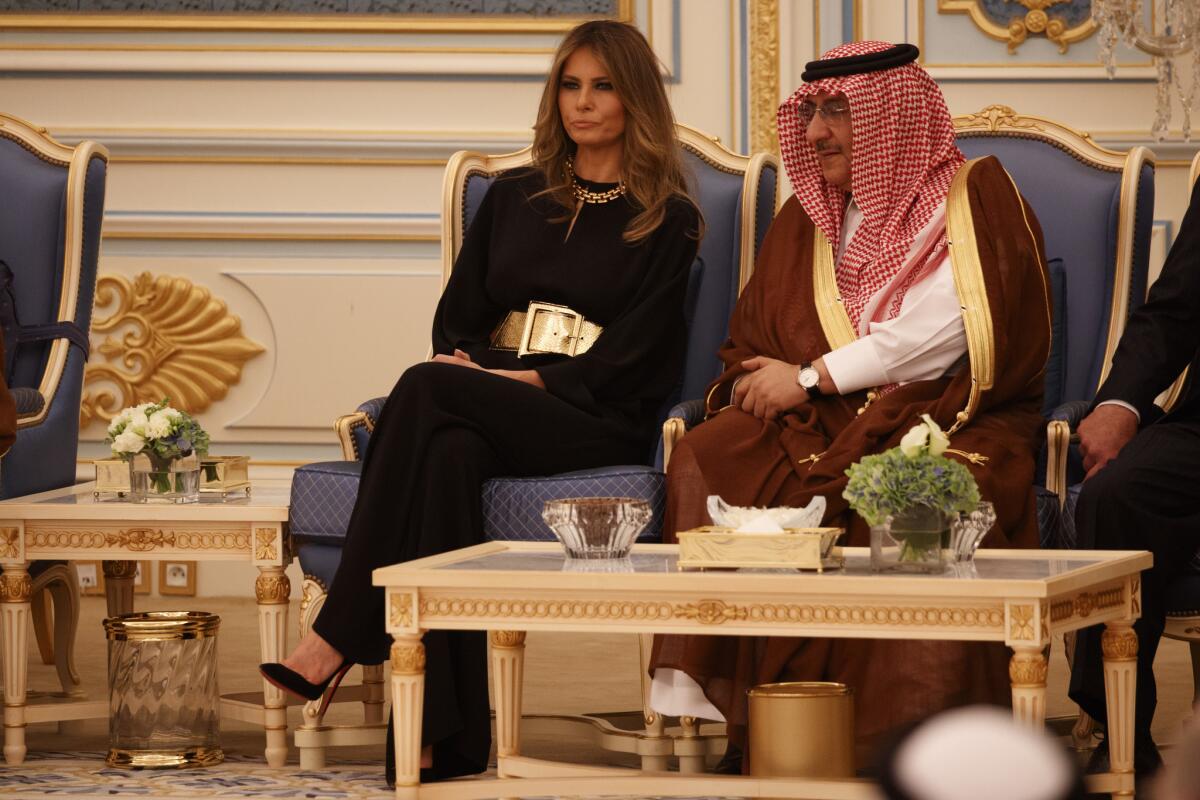Leaving his troubles at home, Trump gets a royal welcome in Saudi Arabia

President Trump started the first foreign trip of his administration in Saudi Arabia. (May 22, 2017) (Sign up for our free video newsletter here http://bit.ly/2n6VKPR)
Reporting from Riyadh, Saudi Arabia — President Trump was greeted with elaborate pomp in Saudi Arabia’s capital Saturday, his first day of a five-country tour that will test his capacity to manage complex international diplomacy while the White House faces a growing political crisis at home.
In choosing the oil-rich kingdom as his first foreign stop since taking office, Trump found a host eager to use all the opulent symbols of state to seek a reboot in relations after the strains of the Obama era.
In a ceremony at the lavish Royal Court, King Salman presented Trump with the nation’s highest honor, the Collar of Abdulaziz Al Saud, for “his quest to enhance security and peace in the region and the world.”
Hours earlier, Salman personally greeted Trump on a red carpet at the foot of Air Force One before a dramatic flyover of military aircraft honored the visiting president.
When Obama last visited, in April 2016, the king famously snubbed him, sending the governor of Riyadh to welcome him on the runway while the king greeted other visitors at the airport.
If the Saudis worried about Trump’s harsh language during the campaign — when he called for a “total and complete shutdown of Muslims entering the United States” — they clearly had forgiven him.
By day’s end, Trump and members of his Cabinet were swaying to the music and chanting of a traditional sword dance as part of an extravagant dinner in his honor at a second royal palace.
The Saudis had objected to Obama almost from the start. They didn’t approve of his abandoning Egypt’s leader during the so-called Arab Spring uprisings in 2011, for failing to hold his red line against Syrian President Bashar Assad in 2012, for easing sanctions on Iran as part of the nuclear deal in 2015 and for promoting liberties that many Saudis don’t enjoy.
Trump was accompanied by his daughter Ivanka and First Lady Melania Trump. Like many foreign women, neither wore the head scarf that women in Saudi Arabia are legally required to wear in public.
Their failure to do so was notable only because in January 2015, Trump complained on Twitter that Saudis were “insulted” that Michelle Obama appeared here without a head scarf.

First Lady Melania Trump talks with Saudi Crown Prince Muhammad bin Nayef at the Royal Court Palace in Riyadh, Saudi Arabia, on May 20, 2017.
Beyond the ceremonies, Trump and the king signed agreements locking in a $110-billion package of arms sales to Saudi Arabia and investments in the U.S. economy.
Parts of the arms-sale agreement were set into motion under the Obama administration, but Trump took credit for the final product.
“That was a tremendous day. Tremendous investments in the United States. Hundreds of billions of dollars of investments into the United States and jobs, jobs, jobs,” he told reporters later.
Secretary of State Rex Tillerson said the arms deal “lowers the demands on our own military, but it also lowers the cost to the American people of providing security in this region.”
The two leaders also issued what they called a “Joint Strategic Vision Declaration” that each side cast as a major step forward in the seven decades of bilateral relations.
Although the White House has struggled at home, Trump’s team has been invested in making his first foreign trip a success since the earliest days of the administration.
Recognizing their inexperience in running a major foreign trip, the White House enlisted several veterans of President George W. Bush’s advance teams, overseen by Trump’s deputy chief of staff, Joe Hagin, also a former Bush official.
Before landing in Riyadh, White House Chief of Staff Reince Priebus told reporters on Air Force One that the president spent the flight meeting with staff, reading newspapers and working on a major speech on Islam he is scheduled to deliver Sunday to the Arab Islamic Summit.
The rest of the flight was spent getting very little sleep, Priebus said.
White House officials have alternately been eagerly awaiting the trip and gritting their teeth over its potential pitfalls.
No modern president has attempted such an ambitious debut on the world stage, and Trump’s itinerary — which also includes a two-day visit to Israel, an audience with Pope Francis at the Vatican and participation in NATO and G7 summits in Brussels and Sicily — is being carefully choreographed to present Trump as a confident commander in chief.
But Trump’s May 9 firing of FBI Director James B. Comey set off fast-moving developments that turned questions over Russian meddling in the 2016 election and Moscow’s potential influence with key Trump aides into a full-blown crisis.
It was from aboard Air Force One that White House Press Secretary Sean Spicer responded to a report in the New York Times that Trump told Russian officials in the Oval Office that his decision to fire Comey — whom he described as “crazy, a real nut job” — had relieved “great pressure” on him over the Russia investigation.
White House officials did not dispute the story, nor a separate Washington Post report that an unnamed senior Trump aide is under federal scrutiny as a person of significant interest to the investigation.
The Comey drama has distracted both the president and some of his top aides as they were meant to be ramping up preparation for the trip.
“As anyone who’s been involved with any of these trips knows, it’s all hands on deck — especially if you have multiple different stops where multiple different agenda topics need to come up,” said Richard Nephew, a senior fellow at the Brookings Institution who worked in the State Department under the Bush and Obama administrations and on Obama’s National Security Council.
“There are lots of pitfalls here, starting with the fact that this administration has been, for obvious reasons, pretty distracted.”
But James Carafano, a foreign policy and national security analyst for the conservative Heritage Foundation who advised the president during the campaign and his transition, said a successful trip could be just what the administration needs.
“The great thing about a foreign trip is, to a great extent, you can stage manage it a lot more,” he said. “It does allow the president to detach a little bit from the heated political debate here in the United States and help him lay out how he’s going to engage in two very critical regions in the world.”
The Saudis’ hospitality spoke to their eagerness to repair relations with Washington. On Sunday, they will host a pair of related summits focused on combating terrorism and preventing radicalization, as well as other perceived threats.
“I think there’s an enormous opportunity in Saudi Arabia to bring the whole Arab world together,” said U.S. Sen. Bob Corker (R-Tenn.) , chairman of the Senate Foreign Relations Committee, who met last week with other senior members of the committee and national security advisor H.R. McMaster, deputy national security advisor Dina Powell and senior advisor Jared Kushner to discuss the visit.
“They felt very neglected. The Iran agreement in particular was one that really caused them to feel like America’s priorities were not with them,” Corker said in an interview. “And then you look at the fact that their relationship with Israel has never been better, it is a tremendous opportunity.”
Despite Saudi unease with the Obama administration’s diplomatic efforts with Iran and Trump’s clear pledge to revisit the deal, Corker said he did not expect the agreement to be a major part of talks.
Adel Jubeir, the Saudi foreign minister, told reporters that Trump and Salman discussed how critical it was that Iran adhere “to the letter” of the agreement.
“We welcome an Iran that is open to the world,” the Saudi diplomat said a day after Iranian voters reelected President Hassan Rouhani, who helped negotiate the Iran nuclear deal. “We welcome an Iran that lives at peace with its neighbor. We welcome an Iran that doesn’t interfere in the affairs of other countries. But this is not the Iran we see.”
For more White House coverage, follow @mikememoli on Twitter.
ALSO
Why Gulf Arab leaders are welcoming Trump’s transactional foreign policy
Trump’s trip is expected to shine a spotlight on the United States’ relationship with Saudi Arabia
Get live updates on our Essential Washington news feed
UPDATES:
2:55 p.m: This article was updated with additional details.
8:40 a.m.: This article was updated with a comment by Trump.
7 a.m.: This article was updated with the signing of an arms-sale agreement and additional details of the day.
12:35 a.m.: This article story was updated with additional details of the arrival formalities.
12:01 a.m.: This article was updated with information about Trump’s flight aboard Air Force One.
This article was originally published at 11:55 p.m.
More to Read
Get the L.A. Times Politics newsletter
Deeply reported insights into legislation, politics and policy from Sacramento, Washington and beyond. In your inbox three times per week.
You may occasionally receive promotional content from the Los Angeles Times.











